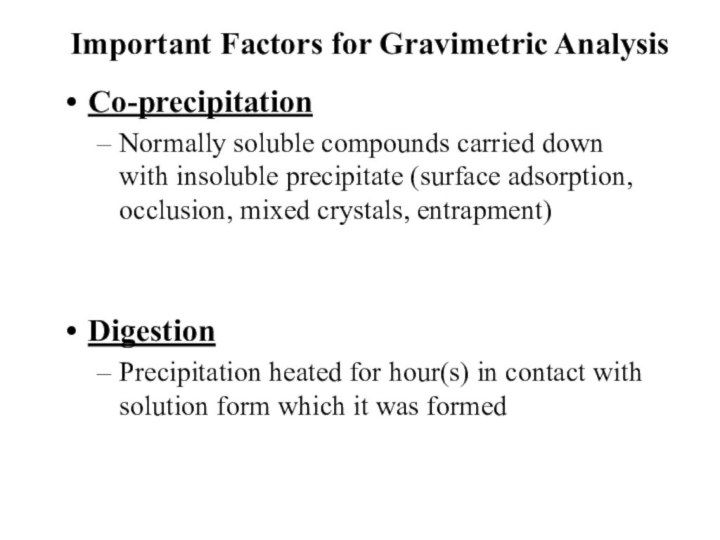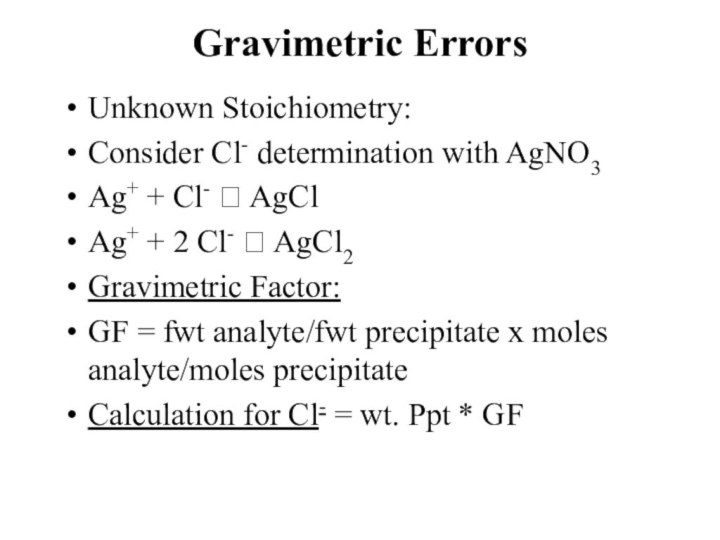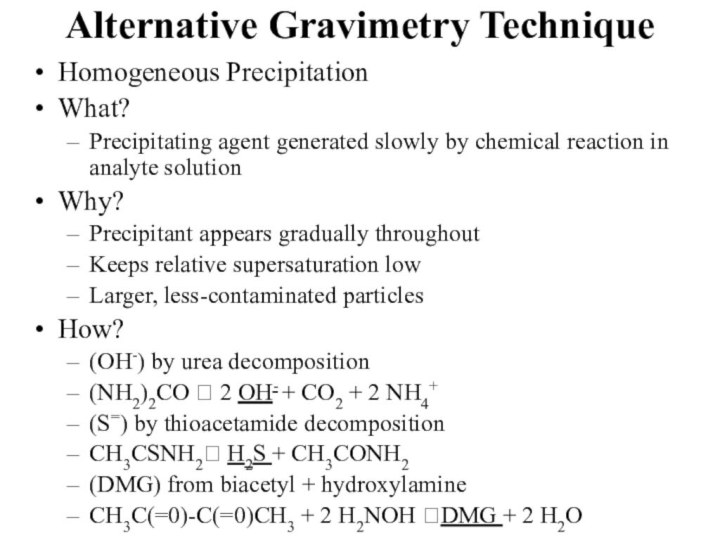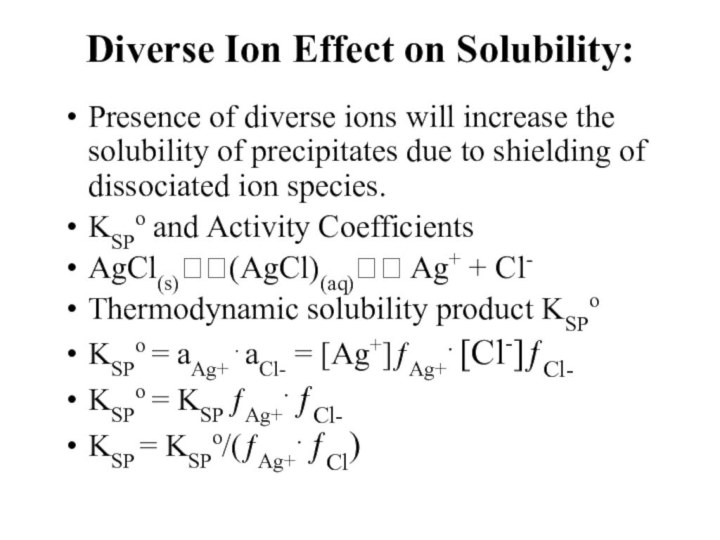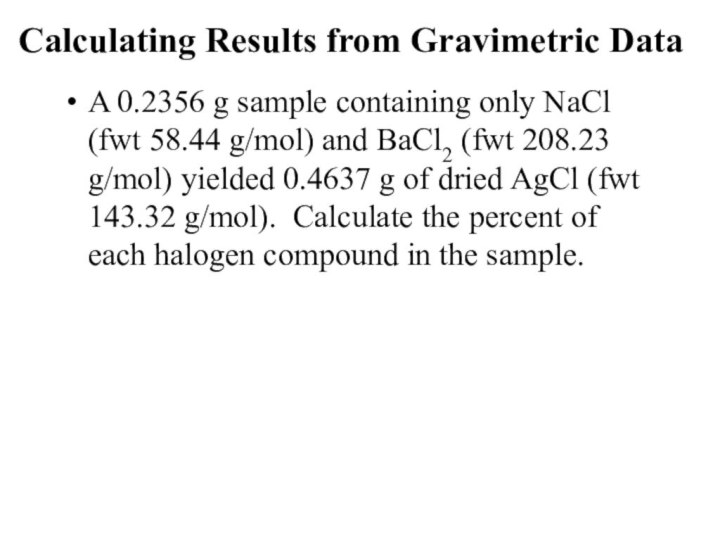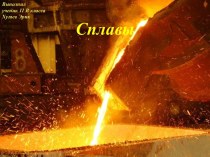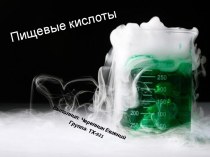Слайд 2
How to Perform a Successful Gravimetric Analysis
What steps
are needed?
Sampled dried, triplicate portions weighed
Preparation of the solution
Precipitation
Digestion
Filtration
Washing
Drying
or igniting
Weighing
Calculation
Слайд 3
Gravimetric Analysis
Gravimetric Analysis – one of the
most accurate and precise methods of macro-quantitative analysis.
Analyte selectively
converted to an insoluble form.
Measurement of mass of material
Correlate with chemical composition
Why?
Simple
Often required for high precision
Слайд 4
Gravimetric Analysis
How?
Quantitative collection of material of known composition
Precipitation
of analyte with selective agent
Volitization and collection of analyte
w/o
loss of material in handling/processing
Free from solvent, impurities
Determination of mass
Direct or
By difference
Слайд 5
Gravimetric Analysis
Precipitation Techniques
Add precipitating reagent to sample solution
Reacts
with analyte to form insoluble material
Precipitate has known composition
or can be converted to known composition
Precipitate handling involves
Quantitative collection (no losses)
Isolation of pure product
Measure mass of precipitate
Calculation of original analyte content (concentration)
Слайд 6
Gravimetric Analysis
Desirable properties of analytical precipitates:
Readily filtered and
purified
Low solubility, preventing losses during filtration and washing
Stable final
form (unreactive)
Known composition after drying or ignition
Слайд 7
Gravimetric Analysis
Precipitating reagents:
Selective
Ag+ + Halides (X-) ?
AgX(s)
Ag+ + CNS- ? AgCNS(s)
Specific
Dimethylglyoxime (DMG)
2 DMG +
Ni2+ ? Ni(DMG)2(s) + 2 H+
Слайд 8
Gravimetric Analysis
Filterability of Precipitates:
Colloidal suspensions
10-7 to 10-4 cm
diameter
Normally remain suspended
Very difficult to filter
Crystalline suspensions
> tenths of
mm diameter
Normally settle out spontaneously
Readily filterable
Слайд 9
Gravimetric Analysis
Filterability of Precipitates:
Precipitate formation affected by
RELATIVE
SUPERSATURATION(R.S.)
R.S. = (Q-S)/S
S = Equilibrium Solubilty of Precipitate
Q =
Instantaneous Concentration
Larger Q leads to colloidal precipitates.
Слайд 10
Important Factors for Gravimetric Analysis
Nucleation
Individual ions/atoms/molecules coalesce
to form “nuclei”
Particle Growth
Condensation of ions/atoms/molecules with existing “nuclei”
forming larger particles which settle out
Colloidal Suspension
Colloidal particles remain suspended due to adsorbed ions giving a net + or - charge
Слайд 11
Important Factors for Gravimetric Analysis
Coagulation, agglomeration
Suspended
colloidal particles coalesce to form larger filterable particles (inert
electrolyte allows closer approach)
Peptization
Re-dissolution of coagulated colloids by washing and removing inert electrolyte
Слайд 12
Important Factors for Gravimetric Analysis
Co-precipitation
Normally soluble compounds
carried down with insoluble precipitate (surface adsorption, occlusion, mixed
crystals, entrapment)
Digestion
Precipitation heated for hour(s) in contact with solution form which it was formed
Слайд 13
Fig. 10.1. Ostwald ripening.
During digestion at elevated
temperature:
Small particles tend to dissolve and reprecipitate on larger
ones.
Individual particles agglomerate.
Adsorbed impurities tend to go into solution.
©Gary Christian, Analytical Chemistry, 6th Ed. (Wiley)
Слайд 14
Fig. 10.2. Representation of silver chloride colloidal particle
and
adsorptive layers when Cl- is in excess.
Cl- adsorbs
on the particles when in excess (primary layer).
A counter layer of cations forms. The neutral double layer causes the colloidal particles to coagulate.
Washing with water will dilute the counter layer and the primary layer charge causes the particles to revert to the colloidal state (peptization). So we wash with an electrolyte that can be volatilized on heating (HNO3).
©Gary Christian, Analytical Chemistry, 6th Ed. (Wiley)
Слайд 15
Organic precipitating agents are chelating agents.
They form
insoluble metal chelates.
©Gary Christian, Analytical Chemistry, 6th Ed.
(Wiley)
Слайд 16
Gravimetric Analysis
Calculations of analyte content requires knowledge of
:
Chemistry
Stoichiometry
Composition of precipitate
Слайд 17
Gravimetry and Solution Equiliria
Thermal Conversion to Measurable Form
Removal
of volatile reagents & solvent
Extended heating at 110 to
115 OC
Chemical conversion to known stable form
CaC2O4(s)? CaO(s) + CO(g) + CO2(g)
Volatilization & trapping of component
NaHCO3(aq)+ H2SO4(aq) ? CO2(g)+ H2O + NaHSO4(aq)
Слайд 18
Gravimetric Calculations
Gravimetric Factor (GF):
GF = (fwt analyte
(g/mol)/fwt precipitate(g/mol))x(a(moles analyte/b(moles precipitate))
GF = g analyte/g precipitate
% analyte
= (weight analyte (g)/ weight sample (g)) x 100%
% (w/w) analyte (g) = ((wt ppt (g) x GF)/wt sample) x 100%
Слайд 19
Gravimetric Errors
Unknown Stoichiometry:
Consider Cl- determination with AgNO3
Ag+ +
Cl- ? AgCl
Ag+ + 2 Cl- ? AgCl2
Gravimetric Factor:
GF = fwt analyte/fwt precipitate x moles analyte/moles precipitate
Calculation for Cl- = wt. Ppt * GF
Слайд 21
Gravimetric Errors
Co-precipitation: (w/AgCl)
Слайд 22
Alternative Gravimetry Technique
Homogeneous Precipitation
What?
Precipitating agent generated slowly
by chemical reaction in analyte solution
Why?
Precipitant appears gradually throughout
Keeps
relative supersaturation low
Larger, less-contaminated particles
How?
(OH-) by urea decomposition
(NH2)2CO ? 2 OH- + CO2 + 2 NH4+
(S=) by thioacetamide decomposition
CH3CSNH2? H2S + CH3CONH2
(DMG) from biacetyl + hydroxylamine
CH3C(=0)-C(=0)CH3 + 2 H2NOH ?DMG + 2 H2O
Слайд 24
Precipitation Equilibria:
The Solubility Product
Solubility of Slightly Soluble Salts:
AgCl(s)??(AgCl)(aq)??
Ag+ + Cl-
Solubility Product KSP = ion product
KSP =
[Ag+][Cl-]
Ag2CrO4(s) ?? 2 Ag+ + CrO42-
KSP = [Ag+]2[CrO42-]
Слайд 25
The molar solubility depends on the stoichiometry of
the salt.
A 1:1 salt is less soluble than
a nonsymmetric salt with the same Ksp.
©Gary Christian, Analytical Chemistry, 6th Ed. (Wiley)
Слайд 26
Precipitation Equilibria:
The Common Ion Effect
Common Ion Effect
Will decrease
the solubility of a slightly soluble salt.
Слайд 27
Fig. 10.3. Predicted effect of excess barium ion
on solubility of BaSO4.
The common ion effect is
used to decrease the solubility.
Sulfate concentration is the amount in equilibrium and is equal to the BaSO4 solubility.
In absence of excess barium ion, solubility is 10-5 M.
©Gary Christian, Analytical Chemistry, 6th Ed. (Wiley)
Слайд 28
Diverse Ion Effect on Solubility:
Presence of diverse ions
will increase the solubility of precipitates due to shielding
of dissociated ion species.
KSPo and Activity Coefficients
AgCl(s)??(AgCl)(aq)?? Ag+ + Cl-
Thermodynamic solubility product KSPo
KSPo = aAg+ . aCl- = [Ag+]ƒAg+. [Cl-]ƒCl-
KSPo = KSP ƒAg+. ƒCl-
KSP = KSPo/(ƒAg+. ƒCl)
Слайд 29
Predicted effect of increased ionic strength on solubility
of
BaSO4. Solubility at zero ionic strength is 1.0 x
10-5 M.
Ksp = Ksp0/fAg+fSO42-
Solubility increases with increasing ionic strength as activity coefficients decrease.
©Gary Christian, Analytical Chemistry, 6th Ed. (Wiley)
Слайд 30
Gravimetric calculation using spreadsheet.
Cell B3 calculates %Fe from
g. Fe2O3 (Cell D2) and g. sample (Cell B2).
©Gary Christian, Analytical Chemistry, 6th Ed. (Wiley)
Слайд 31
Using Exel Solver to calculate solubility.
Enter the formula
(=s2/Ksp) in Cell E4 (don’t enter =1; that goes
in Solver).
The value of s (Cell C4) is changed iteratively until the formula equals 1.
©Gary Christian, Analytical Chemistry, 6th Ed. (Wiley)
Слайд 32
Calculating Results from Gravimetric Data
The calcium in a
200.0 mL sample of a natural water was determined
by precipitating the cation as CaC2O4. The precipitate was filtered, washed, and ignited in a crucible with an empty mass of 26.6002 g. The mass of the crucible plus CaO (fwt 56.077 g/mol) was 26.7134 g. Calculate the concentration of Ca (fwt 40.078 g/mol) in the water in units of grams per 100 mL.
Слайд 33
Calculating Results from Gravimetric Data
An iron ore was
analyzed by dissolving a 1.1324 g sample in concentrated
HCl. The resulting solution was diluted with water, and the iron(III) was precipitated as the hydrous oxide Fe2O3.xH2O by addition of NH3. After filtration and washing, the residue was ignited at high temperature to give 0.5394 g pure Fe2O3 (fwt 159.69 g/mol). Calculate (a) the % Fe (fwt 55.847 g/mol) and (b) % Fe3O4 (fwt 231.54 g/mol) in the sample.











